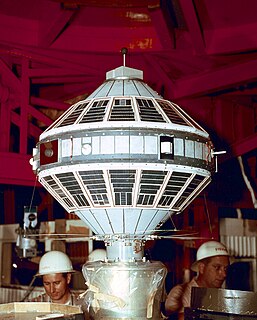 W
WEvents from the year 1959 in the United States. With the admittance of Alaska and Hawaii, this is the last year in which states are added to the union.
 W
WThe state visit of Nikita Khrushchev to the United States was a 13-day visit from 15–27 September 1959. It marked the first state visit of a Soviet leader to the US. Khrushchev, then General Secretary of the Communist Party of the Soviet Union and Chairman of the Council of Ministers, was also the first ethnic Ukrainian leader to set foot in the Western Hemisphere. Being the first visit by a leader of his kind, the coverage of it resulted in an extended media circus.
 W
WExplorer 7 was launched October 13, 1959 at 10:36 a.m. Eastern Time by a Juno II rocket from Cape Canaveral Air Force Station to an orbit of 573 km by 1073 km and inclination of 50.27°. It was designed to measure solar x-ray and Lyman-alpha flux, trapped energetic particles, and heavy primary cosmic rays. Secondary objectives included collecting data on micrometeoroid penetration, molecular sputtering and studying the Earth-atmosphere heat balance.
 W
WIn 1959, the United States FBI, under Director J. Edgar Hoover, continued for a tenth year to maintain a public list of the people it regarded as the Ten Most Wanted Fugitives.
 W
WThe emigration of Cubans, from the 1959 Cuban Revolution to October of 1962, has been dubbed the Golden exile and the first emigration wave in the greater Cuban exile. The exodus was referred to as the "Golden exile" because of the mainly upper and middle class character of the emigrants. After the success of the revolution various Cubans who had allied themselves or worked with the overthrown Batista regime fled the country. Later as the Fidel Castro government began nationalizing industries many Cuban professionals would flee the island. This period of the Cuban exile is also referred to as the Historical exile, mainly by those who emigrated during this period.
 W
WThe Admission Act, formally An Act to Provide for the Admission of the State of Hawaii into the Union is a statute enacted by the United States Congress and signed into law by President Dwight D. Eisenhower which dissolved the Territory of Hawaii and established the State of Hawaii as the 50th state to be admitted into the Union. Statehood became effective on August 21, 1959. Hawaii remains the most recent state to join the United States.
 W
WKīlauea Iki is a pit crater that is next to the main summit caldera of Kīlauea on the island of Hawaiʻi in the Hawaiian Islands.
 W
WThe 1959 Okinawa F-100 crash, also known as the Miyamori Elementary School crash (宮森小学校米軍機墜落事故), occurred on June 30, 1959, when a North American F-100 Super Sabre of the United States Air Force crashed in Ishikawa, in United States-occupied Okinawa, killing 18 people.
 W
WVanguard 2 or Vanguard II is an Earth-orbiting satellite launched 17 February 1959, aboard a Vanguard SLV-4 rocket as part of the United States Navy's Project Vanguard. The satellite was designed to measure cloud-cover distribution over the daylight portion of its orbit, for a period of 19 days, and to provide information on the density of the atmosphere for the lifetime of its orbit. As the first weather satellite and one of the first orbital space missions, the launch of Vanguard 2 was an important milestone in the space race between the United States and the Soviet Union. As of January 2020, Vanguard 2 was still in orbit.